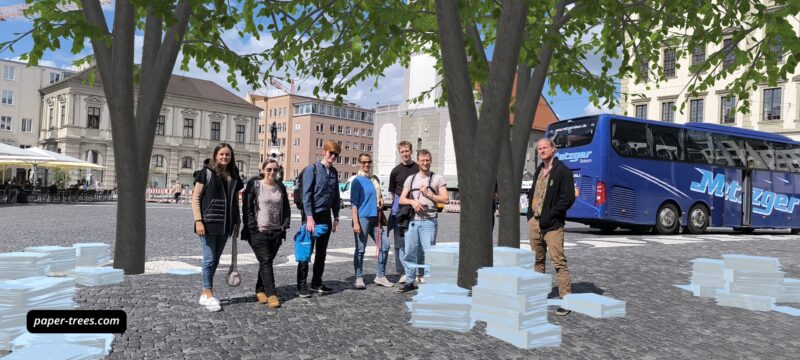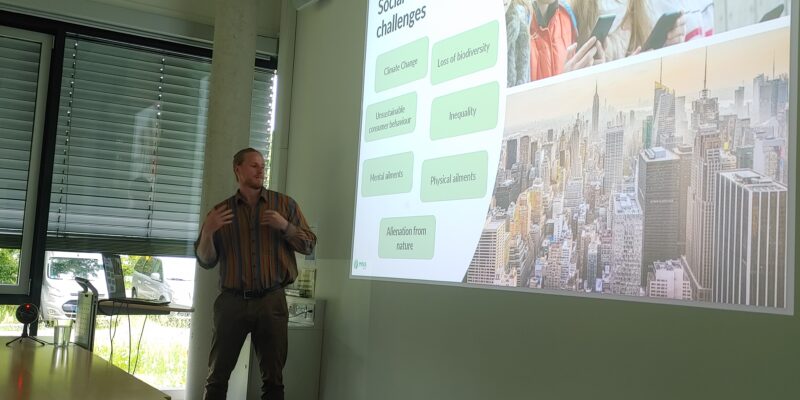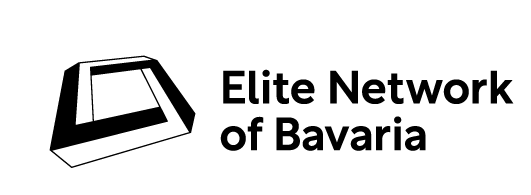REVIEW ARTIST WORKSHOP: “RE-THINKING FORESTS: ARTISTIC PRACTICES, DIGITAL MEDIA, AND THE ROLE OF EXPERIENCE.” WITH EVA-MARIA LÓPEZ AND MANY OTHERS

Kirsten Twelbeck
In the Forest
The second IDK artist workshop started in drizzling rain, but never mind. Forester Wolfgang Sailer led our group through the Siebentischwald, explaining about the history of the forest and its immense importance for the health of the city’s population. At some point we stopped to follow photographer/environmental educator and PhD student Pia Wimmer along a narrow path among the trees, with eyes closed. What has become known as “forest bathing” turned out to be a perfect start for the creative activity that followed when artist Eva-Maria Lopez distributed paper and colored wax to not only create so-called “frottages” (a creative technique used, e.g. by Surrealist Max Ernst) but to interact with the forest in an unusual, physical way. Pia encouraged us to also take pictures with our mobile phones—an approach that very much depends upon cultural experiences and routines with the medium of photography and the phenomenon of the “selfie.” The playful exercise inspired in-depth thinking about what it means to “represent” a forest, how “authentic” such representations are, and how we rely on our senses to create particular types of experience.

Kirsten Twelbeck
On the Square
After providing an overview of her career as an artist who has worked on environmental themes for a very long time (“Green Hour with Eva-Maria López”), we took the tram to Augsburg’s Main Square where we had the chance to experience the artist’s latest intervention into the status quo: Eva-Maria’s Paper Trees app relies on augmented reality to make us hopeful against all odds: the amount of paper that is used by the Augsburg population during one year is miraculously turned into trees that create shade and fresh air and a highly attractive public space.
As Wolfgang Sailer had explained to us during our morning walk, temperatures in a forest are 4 to 5 degrees (Celsius) below city temperatures. It makes a lot of sense, then, to bring more trees into cities—not only trees lining the streets, but larger assemblies, to fight the effects of global warming on all species.

, FC : (0,0,0)
Kirsten Twelbeck
Tiny Forest
Caspar Möller from Miya Forest Eberswalde (www.miya-forest.de) explained the aims of the project and showed many examples of tree planting projects in inner city areas.

Kirsten Twelbeck
Panel
The panel on “Digital Humanities, Art, and the Environment” brought together Caspar Möller, Eva-Maria Lopez, Stefan Lindl (historian, online), and Pia Wimmer to discuss how the use of digital media art can support the making of more sustainable, climate-friendly cities, but also the limits of digitalization.

Kirsten Twelbeck
Workshop
During the workshop with Eva, we continued our creative engagement with the forest and what we found there in the morning. And we talked about how physical encounters with leaves, bark, tiny branches etc. differ from photography and digital artwork.
by: Kirsten Twelbeck
